标签:添加空格 symbols symbol -- 十进制 play useful hal default

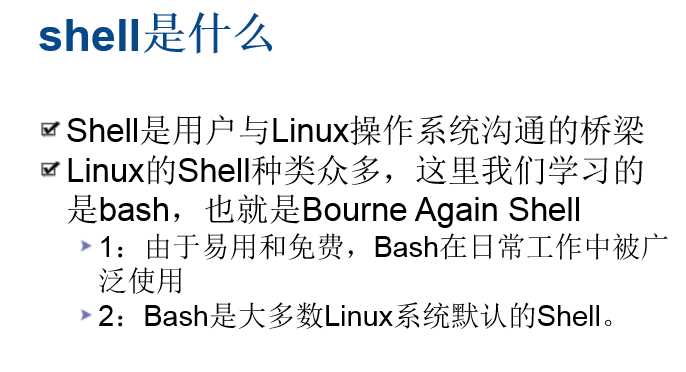
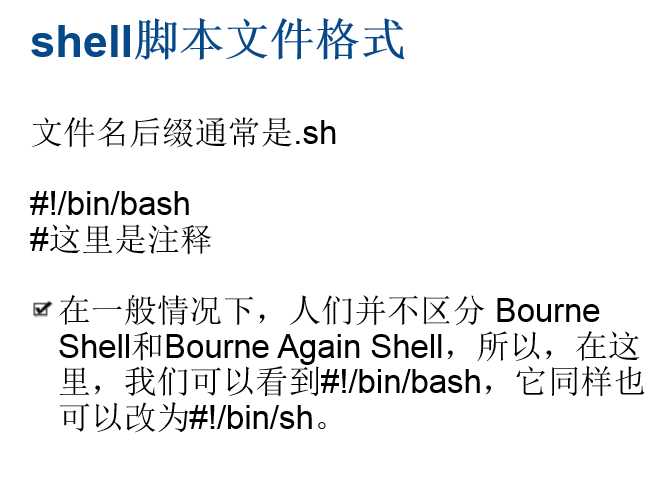

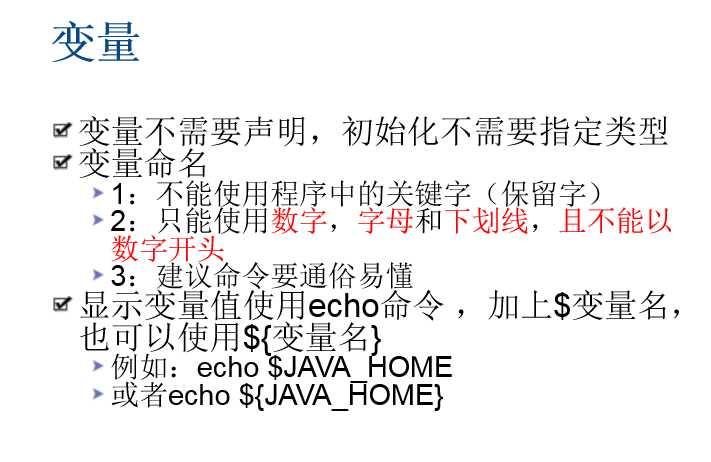

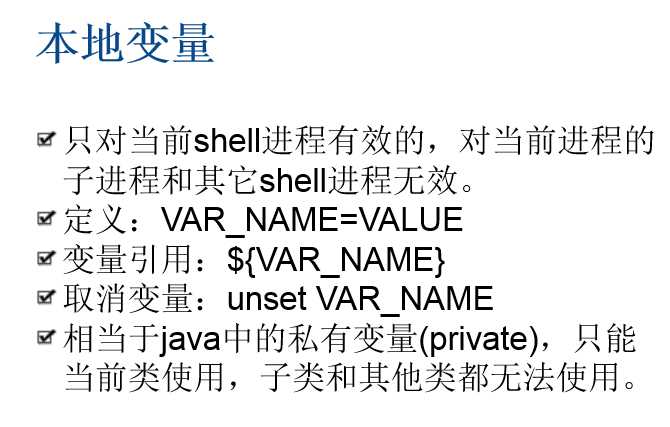
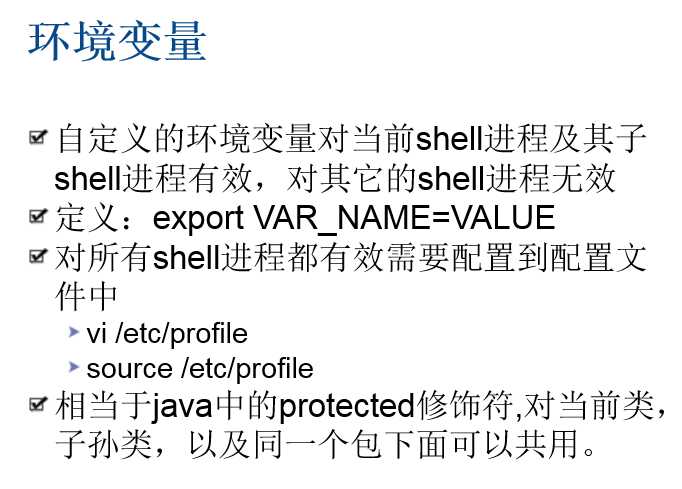
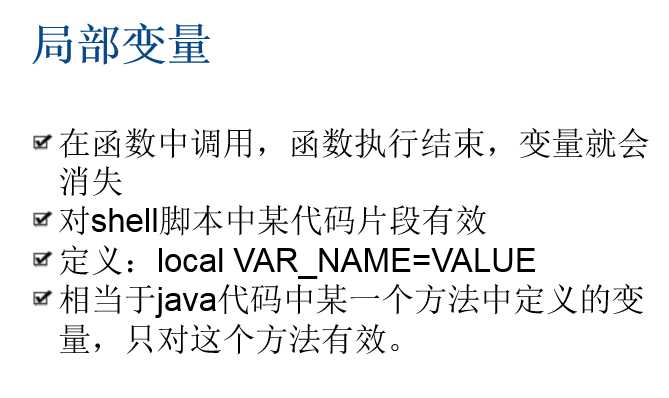
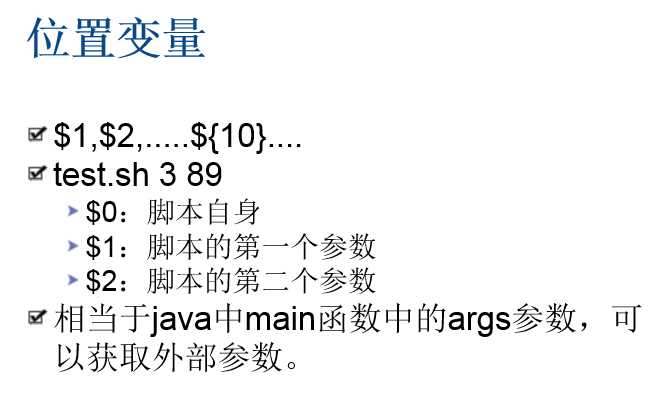
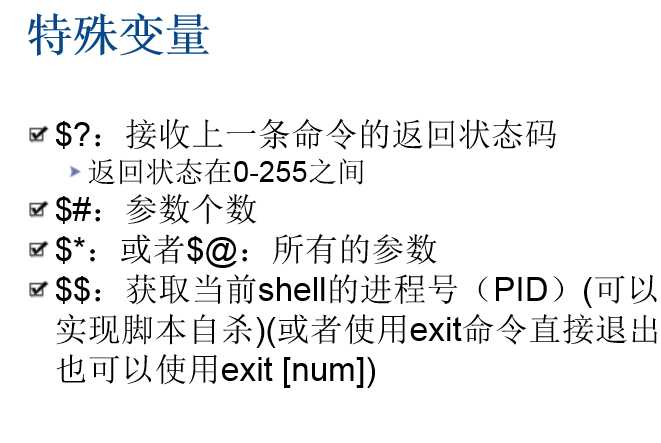

#!/bin/bash
echo "前进程号:"$$
echo "start"
sleep 10
kill $$
sleep 900000000
echo "end"

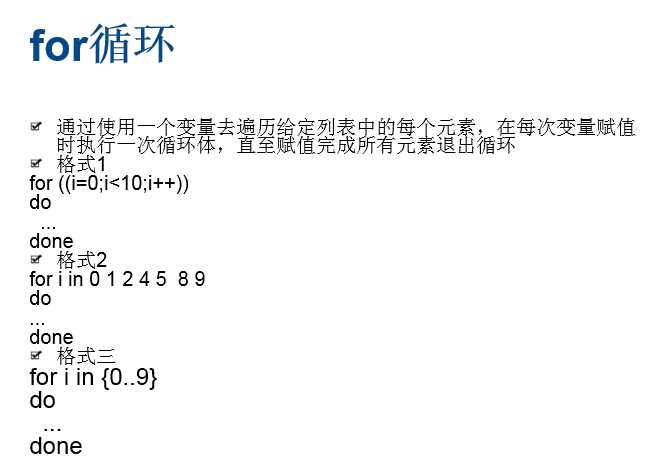

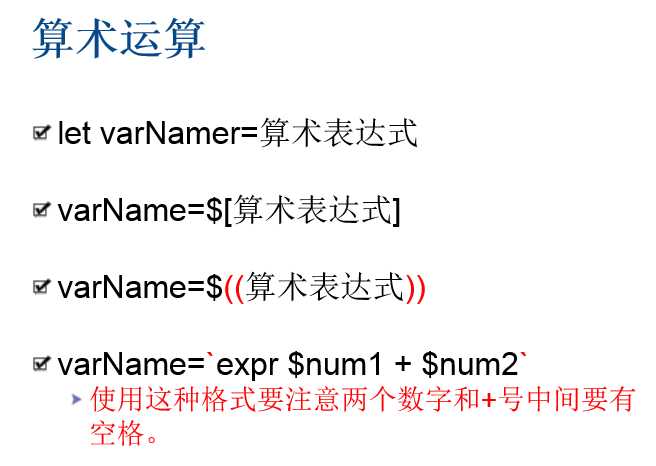
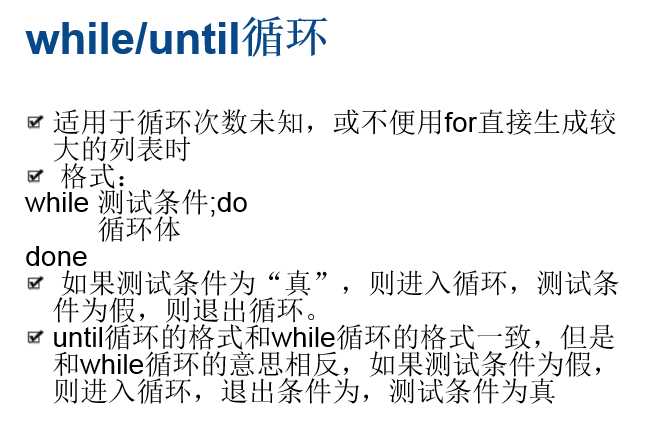
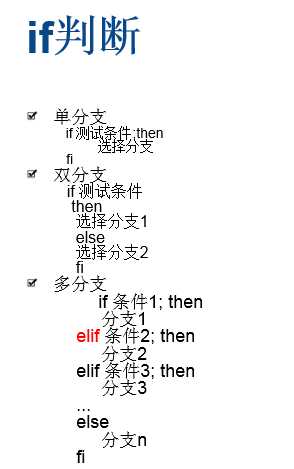
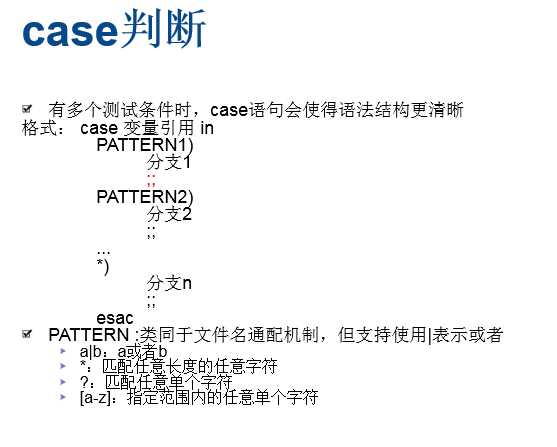
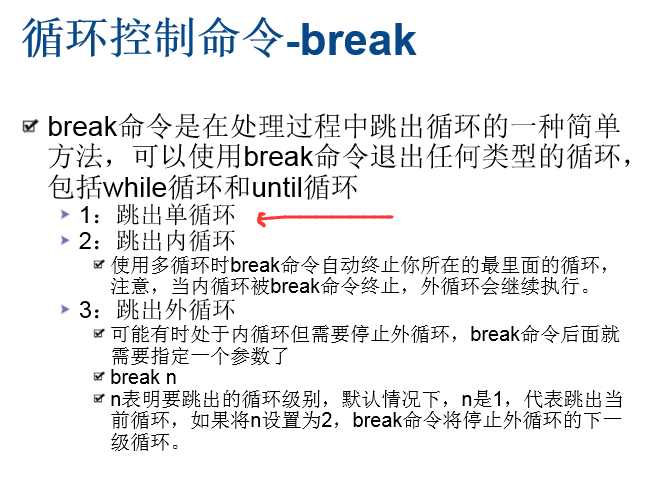
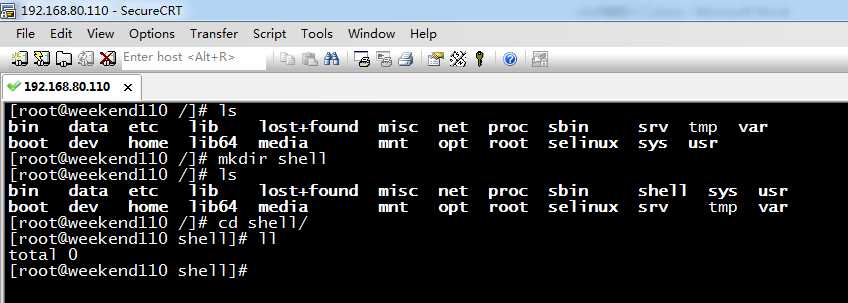
这里,我就在,/下新建shell目录,用来作为shell编程的入门。
[root@weekend110 /]# ls
bin data etc lib lost+found misc net proc sbin srv tmp var
boot dev home lib64 media mnt opt root selinux sys usr
[root@weekend110 /]# mkdir shell
[root@weekend110 /]# ls
bin data etc lib lost+found misc net proc sbin shell sys usr
boot dev home lib64 media mnt opt root selinux srv tmp var
[root@weekend110 /]# cd shell/
[root@weekend110 shell]# ll
total 0
[root@weekend110 shell]#

[root@weekend110 shell]# ls
[root@weekend110 shell]# vim break1.sh
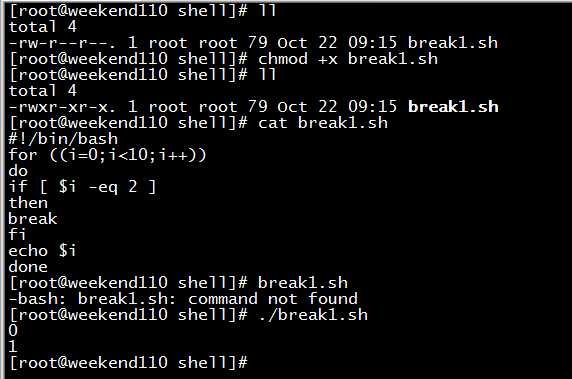
[root@weekend110 shell]# ll
total 4
-rw-r--r--. 1 root root 79 Oct 22 09:15 break1.sh
[root@weekend110 shell]# chmod +x break1.sh
[root@weekend110 shell]# ll
total 4
-rwxr-xr-x. 1 root root 79 Oct 22 09:15 break1.sh
[root@weekend110 shell]# cat break1.sh //如果变量i达到2,就跳出循环
#!/bin/bash
for ((i=0;i<10;i++))
do
if [ $i -eq 2 ]
then
break
fi
echo $i
done
[root@weekend110 shell]# break1.sh
-bash: break1.sh: command not found
[root@weekend110 shell]# ./break1.sh 因为,此刻,还没加入到环境变量
0
1
[root@weekend110 shell]#

[root@weekend110 shell]# pwd
/shell
[root@weekend110 shell]# vim /etc/profile
export PATH=$PATH:/shell/
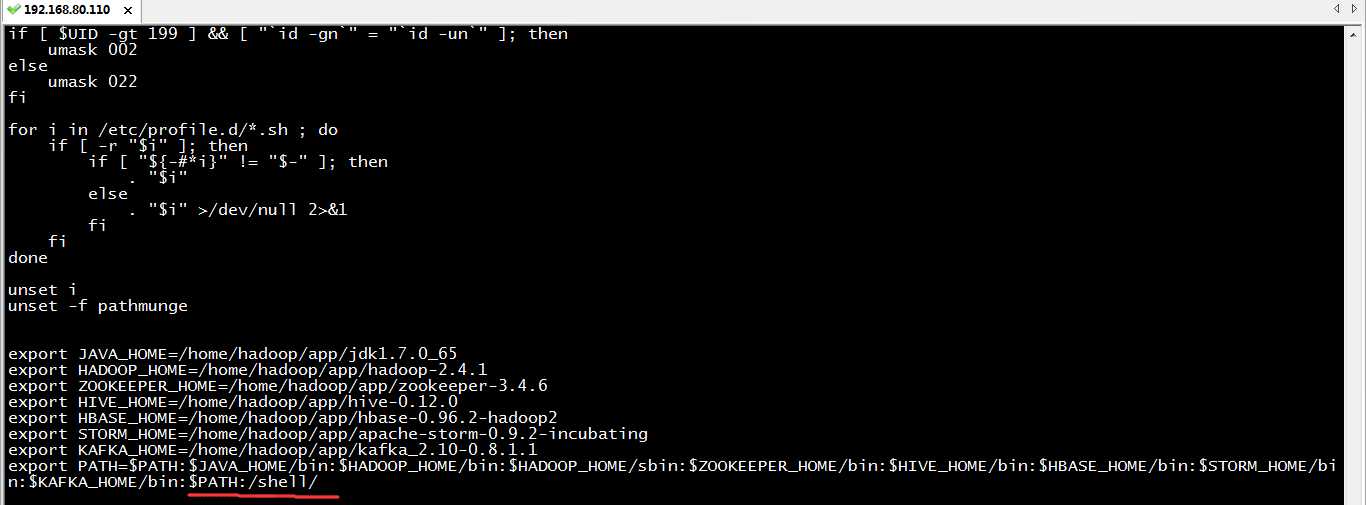

[root@weekend110 shell]# source /etc/profile
[root@weekend110 shell]# break1.sh
0
1
[root@weekend110 shell]#
这样,就达到了。
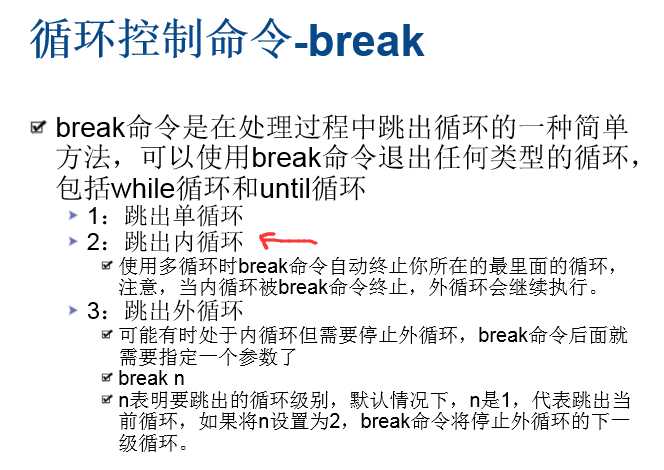
现在,写,while循环在外,for循环在内。
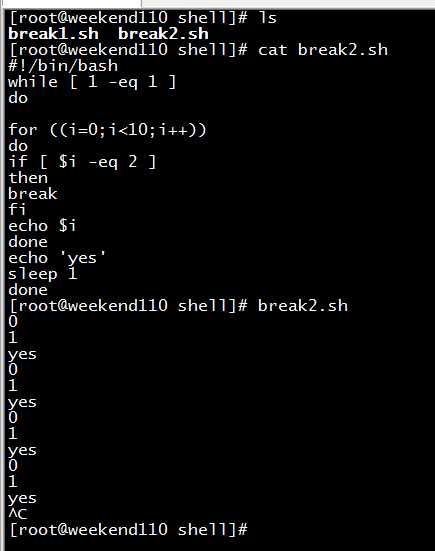
[root@weekend110 shell]# ls
break1.sh break2.sh
[root@weekend110 shell]# cat break2.sh
#!/bin/bash
while [ 1 -eq 1 ]
do
for ((i=0;i<10;i++))
do
if [ $i -eq 2 ]
then
break
fi
echo $i
done
echo ‘yes‘
sleep 1
done
[root@weekend110 shell]# break2.sh
0
1
yes
0
1
yes
0
1
yes
0
1
yes
^C
[root@weekend110 shell]#
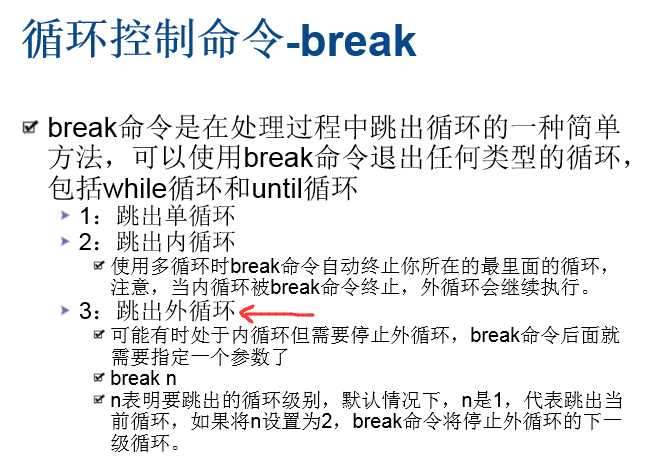
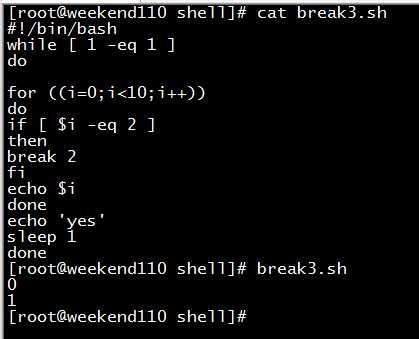
[root@weekend110 shell]# cat break3.sh
#!/bin/bash
while [ 1 -eq 1 ]
do
for ((i=0;i<10;i++))
do
if [ $i -eq 2 ]
then
break 2 //在这里,默认是1,写个2,则说的是跳出2层循环。
fi
echo $i
done
echo ‘yes‘
sleep 1
done
[root@weekend110 shell]# break3.sh
0
1
[root@weekend110 shell]#
跳出单循环
for((i=0;i<10;i++))
do
echo $i
if [ $i -eq 2 ]
then
break
fi
done
跳出内循环
while [ 1 -eq 1 ]
do
echo ‘yes‘
sleep 1
for((i=0;i<10;i++))
do
echo $i
if [ $i -eq 2 ]
then
break
fi
done
done
跳出外循环
while [ 1 -eq 1 ]
do
echo ‘yes‘
sleep 1
for((i=0;i<10;i++))
do
echo $i
if [ $i -eq 2 ]
then
break 2
fi
done
done

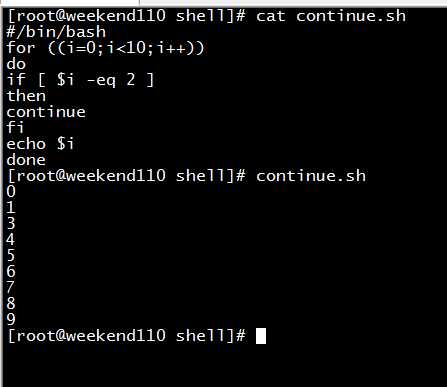
[root@weekend110 shell]# cat continue.sh
#/bin/bash
for ((i=0;i<10;i++))
do
if [ $i -eq 2 ]
then
continue
fi
echo $i
done
[root@weekend110 shell]# continue.sh
0
1
3
4
5
6
7
8
9
[root@weekend110 shell]#
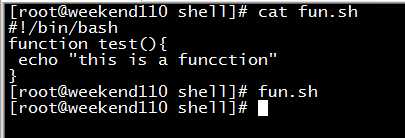
[root@weekend110 shell]# cat fun.sh
#!/bin/bash
function test(){
echo "this is a funcction"
}
[root@weekend110 shell]# fun.sh
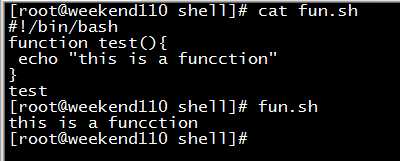
[root@weekend110 shell]# cat fun.sh
#!/bin/bash
function test(){
echo "this is a funcction"
}
test
[root@weekend110 shell]# fun.sh
this is a funcction
[root@weekend110 shell]#
但是,一般,生产里,也不会这么去做。
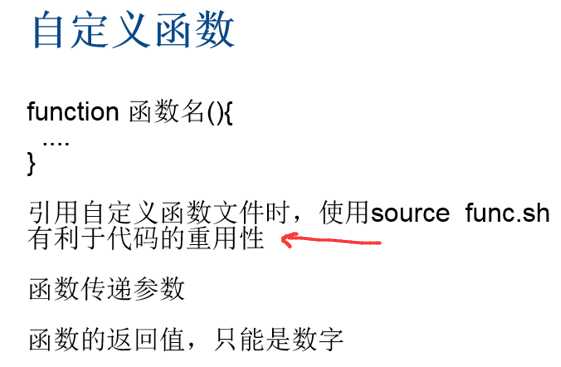
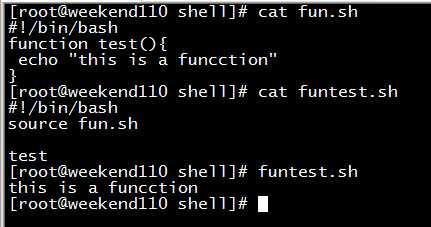
[root@weekend110 shell]# cat fun.sh
#!/bin/bash
function test(){
echo "this is a funcction"
}
[root@weekend110 shell]# cat funtest.sh
#!/bin/bash
source fun.sh
test
[root@weekend110 shell]# funtest.sh
this is a funcction
[root@weekend110 shell]#
这样的好处,是fun.sh脚本,可以重用。
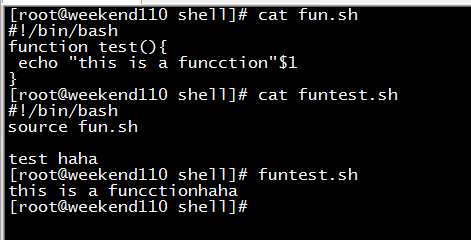
[root@weekend110 shell]# cat fun.sh
#!/bin/bash
function test(){
echo "this is a funcction"$1
}
[root@weekend110 shell]# cat funtest.sh
#!/bin/bash
source fun.sh
test haha
[root@weekend110 shell]# funtest.sh
this is a funcctionhaha
[root@weekend110 shell]#
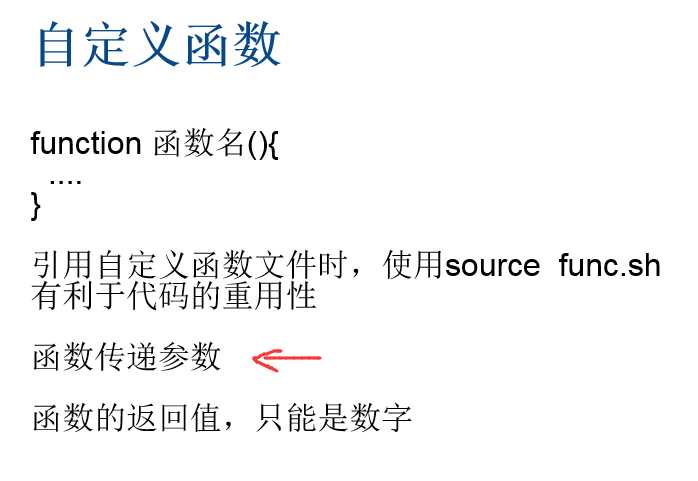
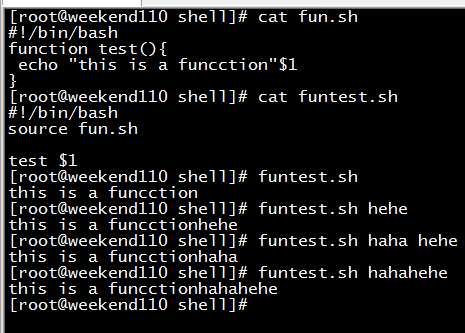
[root@weekend110 shell]# cat fun.sh
#!/bin/bash
function test(){
echo "this is a funcction"$1
}
[root@weekend110 shell]# cat funtest.sh
#!/bin/bash
source fun.sh
test $1
[root@weekend110 shell]# funtest.sh
this is a funcction
[root@weekend110 shell]# funtest.sh hehe
this is a funcctionhehe
[root@weekend110 shell]# funtest.sh haha hehe
this is a funcctionhaha
[root@weekend110 shell]# funtest.sh hahahehe
this is a funcctionhahahehe
[root@weekend110 shell]#
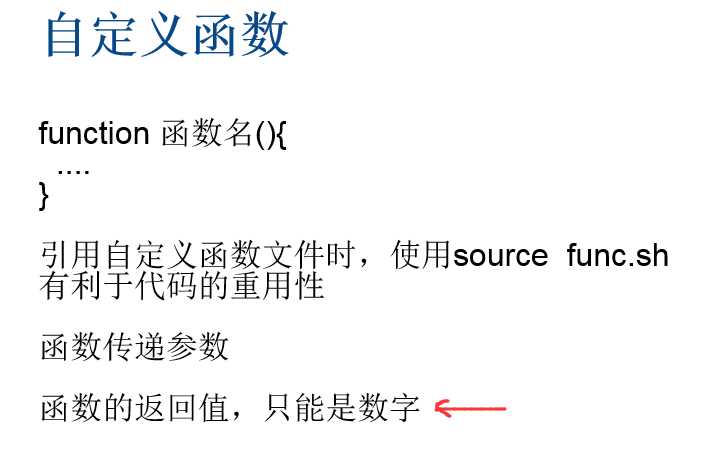
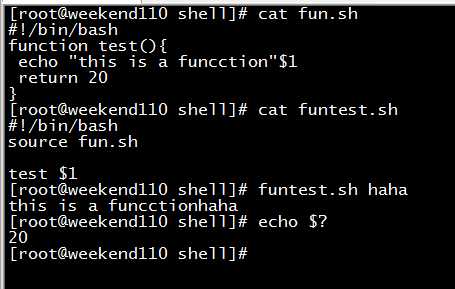
[root@weekend110 shell]# cat fun.sh
#!/bin/bash
function test(){
echo "this is a funcction"$1
return 20
}
[root@weekend110 shell]# cat funtest.sh
#!/bin/bash
source fun.sh
test $1
[root@weekend110 shell]# funtest.sh haha
this is a funcctionhaha
[root@weekend110 shell]# echo $?
20
[root@weekend110 shell]#
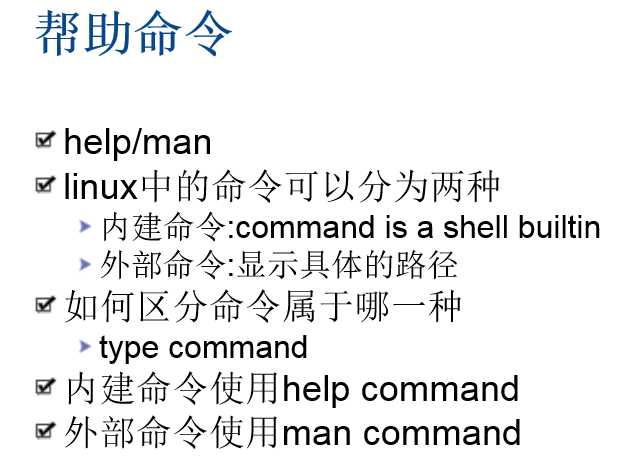

[root@weekend110 shell]# type cd
cd is a shell builtin
[root@weekend110 shell]# type date
date is hashed (/bin/date)
[root@weekend110 shell]#
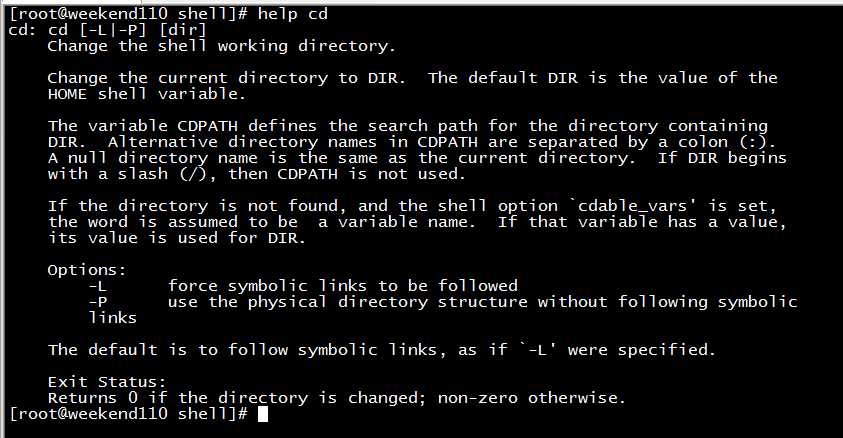
[root@weekend110 shell]# help cd
cd: cd [-L|-P] [dir]
Change the shell working directory.
Change the current directory to DIR. The default DIR is the value of the
HOME shell variable.
The variable CDPATH defines the search path for the directory containing
DIR. Alternative directory names in CDPATH are separated by a colon (:).
A null directory name is the same as the current directory. If DIR begins
with a slash (/), then CDPATH is not used.
If the directory is not found, and the shell option `cdable_vars‘ is set,
the word is assumed to be a variable name. If that variable has a value,
its value is used for DIR.
Options:
-L force symbolic links to be followed
-P use the physical directory structure without following symbolic
links
The default is to follow symbolic links, as if `-L‘ were specified.
Exit Status:
Returns 0 if the directory is changed; non-zero otherwise.
[root@weekend110 shell]#
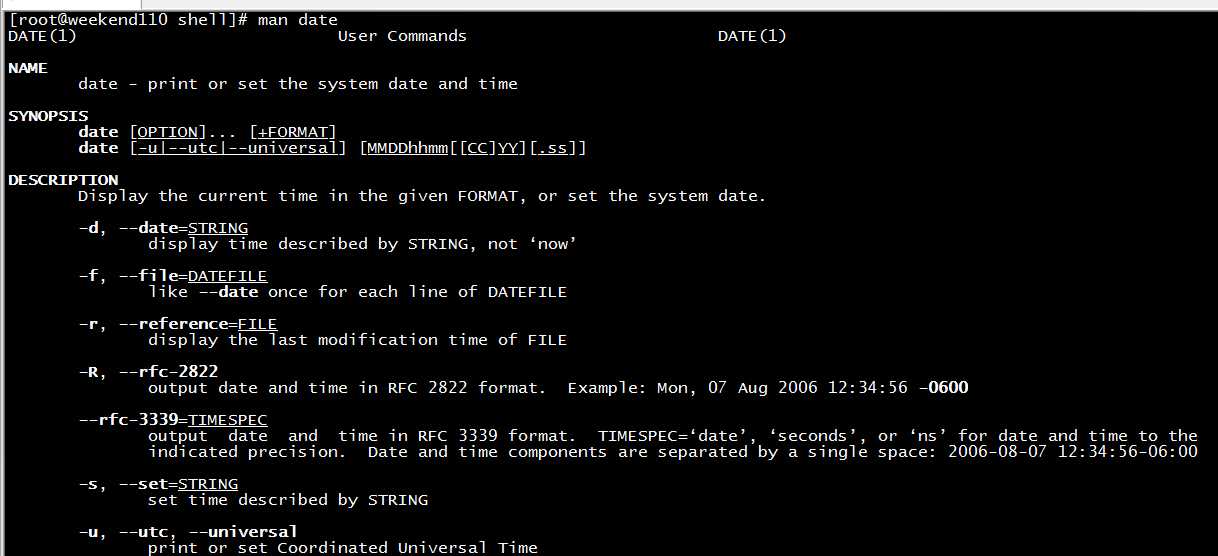
[root@weekend110 shell]# man date 按长空格键,翻页
DATE(1) User Commands DATE(1)
NAME
date - print or set the system date and time
SYNOPSIS
date [OPTION]... [+FORMAT]
date [-u|--utc|--universal] [MMDDhhmm[[CC]YY][.ss]]
DESCRIPTION
Display the current time in the given FORMAT, or set the system date.
-d, --date=STRING
display time described by STRING, not ‘now’
-f, --file=DATEFILE
like --date once for each line of DATEFILE
-r, --reference=FILE
display the last modification time of FILE
-R, --rfc-2822
output date and time in RFC 2822 format. Example: Mon, 07 Aug 2006 12:34:56 -0600
--rfc-3339=TIMESPEC
output date and time in RFC 3339 format. TIMESPEC=‘date’, ‘seconds’, or ‘ns’ for date and time to the
indicated precision. Date and time components are separated by a single space: 2006-08-07 12:34:56-06:00
-s, --set=STRING
set time described by STRING
-u, --utc, --universal
print or set Coordinated Universal Time
--help display this help and exit
:
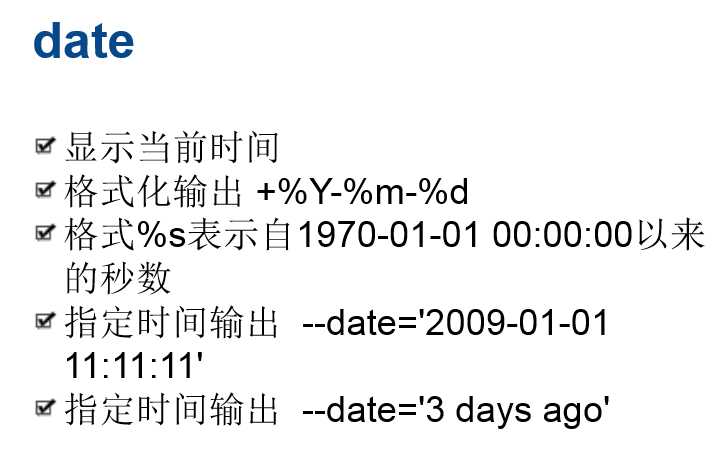

[root@weekend110 shell]# type date
date is hashed (/bin/date)
[root@weekend110 shell]# man date
DATE(1) User Commands DATE(1)
NAME
date - print or set the system date and time
SYNOPSIS
date [OPTION]... [+FORMAT]
date [-u|--utc|--universal] [MMDDhhmm[[CC]YY][.ss]]
DESCRIPTION
Display the current time in the given FORMAT, or set the system date.
-d, --date=STRING
display time described by STRING, not ‘now’
-f, --file=DATEFILE
like --date once for each line of DATEFILE
-r, --reference=FILE
display the last modification time of FILE
-R, --rfc-2822
output date and time in RFC 2822 format. Example: Mon, 07 Aug 2006 12:34:56 -0600
--rfc-3339=TIMESPEC
output date and time in RFC 3339 format. TIMESPEC=‘date’, ‘seconds’, or ‘ns’ for date and time to the
indicated precision. Date and time components are separated by a single space: 2006-08-07 12:34:56-06:00
-s, --set=STRING
set time described by STRING
-u, --utc, --universal
print or set Coordinated Universal Time
--help display this help and exit
--version
output version information and exit
FORMAT controls the output. Interpreted sequences are:
%% a literal %
%a locale’s abbreviated weekday name (e.g., Sun)
%A locale’s full weekday name (e.g., Sunday)
%b locale’s abbreviated month name (e.g., Jan)
%B locale’s full month name (e.g., January)
%c locale’s date and time (e.g., Thu Mar 3 23:05:25 2005)
%C century; like %Y, except omit last two digits (e.g., 20)
%d day of month (e.g, 01)
%D date; same as %m/%d/%y
%e day of month, space padded; same as %_d
%F full date; same as %Y-%m-%d
%g last two digits of year of ISO week number (see %G)
%G year of ISO week number (see %V); normally useful only with %V
%h same as %b
%H hour (00..23)
%I hour (01..12)
%j day of year (001..366)
%k hour ( 0..23)
%l hour ( 1..12)
%m month (01..12)
%M minute (00..59)
%n a newline
%N nanoseconds (000000000..999999999)
%p locale’s equivalent of either AM or PM; blank if not known
%P like %p, but lower case
%r locale’s 12-hour clock time (e.g., 11:11:04 PM)
%R 24-hour hour and minute; same as %H:%M
%s seconds since 1970-01-01 00:00:00 UTC
%S second (00..60)
%t a tab
%T time; same as %H:%M:%S
%u day of week (1..7); 1 is Monday
%U week number of year, with Sunday as first day of week (00..53)
%V ISO week number, with Monday as first day of week (01..53)
%w day of week (0..6); 0 is Sunday
%W week number of year, with Monday as first day of week (00..53)
%x locale’s date representation (e.g., 12/31/99)
%X locale’s time representation (e.g., 23:13:48)
%y last two digits of year (00..99)
%Y year
%z +hhmm numeric timezone (e.g., -0400)
%:z +hh:mm numeric timezone (e.g., -04:00)
%::z +hh:mm:ss numeric time zone (e.g., -04:00:00)
%:::z numeric time zone with : to necessary precision (e.g., -04, +05:30)
%Z alphabetic time zone abbreviation (e.g., EDT)
By default, date pads numeric fields with zeroes. The following optional flags may follow ‘%’:
- (hyphen) do not pad the field
_ (underscore) pad with spaces
0 (zero) pad with zeros
^ use upper case if possible
# use opposite case if possible
After any flags comes an optional field width, as a decimal number; then an optional modifier, which is either E
to use the locale’s alternate representations if available, or O to use the locale’s alternate numeric symbols
if available.
DATE STRING
The --date=STRING is a mostly free format human readable date string such as "Sun, 29 Feb 2004 16:21:42 -0800"
or "2004-02-29 16:21:42" or even "next Thursday". A date string may contain items indicating calendar date,
time of day, time zone, day of week, relative time, relative date, and numbers. An empty string indicates the
beginning of the day. The date string format is more complex than is easily documented here but is fully
described in the info documentation.
ENVIRONMENT
TZ Specifies the timezone, unless overridden by command line parameters. If neither is specified, the set-
ting from /etc/localtime is used.
AUTHOR
Written by David MacKenzie.
REPORTING BUGS
Report date bugs to bug-coreutils@gnu.org
GNU coreutils home page: <http://www.gnu.org/software/coreutils/>
General help using GNU software: <http://www.gnu.org/gethelp/>
Report date translation bugs to <http://translationproject.org/team/>
COPYRIGHT
Copyright ? 2010 Free Software Foundation, Inc. License GPLv3+: GNU GPL version 3 or later
<http://gnu.org/licenses/gpl.html>.
This is free software: you are free to change and redistribute it. There is NO WARRANTY, to the extent permit-
ted by law.
SEE ALSO
The full documentation for date is maintained as a Texinfo manual. If the info and date programs are properly
installed at your site, the command
info coreutils ‘date invocation‘
should give you access to the complete manual.
DATE STRING
The --date=STRING is a mostly free format human readable date string such as "Sun, 29 Feb 2004 16:21:42 -0800"
or "2004-02-29 16:21:42" or even "next Thursday". A date string may contain items indicating calendar date,
time of day, time zone, day of week, relative time, relative date, and numbers. An empty string indicates the
beginning of the day. The date string format is more complex than is easily documented here but is fully
described in the info documentation.
ENVIRONMENT
TZ Specifies the timezone, unless overridden by command line parameters. If neither is specified, the set-
ting from /etc/localtime is used.
AUTHOR
Written by David MacKenzie.
REPORTING BUGS
Report date bugs to bug-coreutils@gnu.org
GNU coreutils home page: <http://www.gnu.org/software/coreutils/>
General help using GNU software: <http://www.gnu.org/gethelp/>
Report date translation bugs to <http://translationproject.org/team/>
COPYRIGHT
Copyright ? 2010 Free Software Foundation, Inc. License GPLv3+: GNU GPL version 3 or later
<http://gnu.org/licenses/gpl.html>.
This is free software: you are free to change and redistribute it. There is NO WARRANTY, to the extent permit-
ted by law.
SEE ALSO
The full documentation for date is maintained as a Texinfo manual. If the info and date programs are properly
installed at your site, the command
info coreutils ‘date invocation‘
should give you access to the complete manual.
GNU coreutils 8.4 November 2013 DATE(1)
man date对应的中文手册
date命令的帮助信息
[root@localhost source]# date --help
用法:date [选项]... [+格式]
或:date [-u|--utc|--universal] [MMDDhhmm[[CC]YY][.ss]]
以给定的格式显示当前时间,或是设置系统日期。
-d,--date=字符串 显示指定字符串所描述的时间,而非当前时间
-f,--file=日期文件 类似--date,从日期文件中按行读入时间描述
-r, --reference=文件 显示文件指定文件的最后修改时间
-R, --rfc-2822 以RFC 2822格式输出日期和时间
例如:2006年8月7日,星期一 12:34:56 -0600
--rfc-3339=TIMESPEC 以RFC 3339 格式输出日期和时间。
TIMESPEC=`date‘,`seconds‘,或 `ns‘
表示日期和时间的显示精度。
日期和时间单元由单个的空格分开:
2006-08-07 12:34:56-06:00
-s, --set=字符串 设置指定字符串来分开时间
-u, --utc, --universal 输出或者设置协调的通用时间
--help 显示此帮助信息并退出
--version 显示版本信息并退出
给定的格式FORMAT 控制着输出,解释序列如下:
%% 一个文字的 %
%a 当前locale 的星期名缩写(例如: 日,代表星期日)
%A 当前locale 的星期名全称 (如:星期日)
%b 当前locale 的月名缩写 (如:一,代表一月)
%B 当前locale 的月名全称 (如:一月)
%c 当前locale 的日期和时间 (如:2005年3月3日 星期四 23:05:25)
%C 世纪;比如 %Y,通常为省略当前年份的后两位数字(例如:20)
%d 按月计的日期(例如:01)
%D 按月计的日期;等于%m/%d/%y
%e 按月计的日期,添加空格,等于%_d
%F 完整日期格式,等价于 %Y-%m-%d
%g ISO-8601 格式年份的最后两位 (参见%G)
%G ISO-8601 格式年份 (参见%V),一般只和 %V 结合使用
%h 等于%b
%H 小时(00-23)
%I 小时(00-12)
%c 按年计的日期(001-366)
%k 时(0-23)
%l 时(1-12)
%m 月份(01-12)
%M 分(00-59)
%n 换行
%N 纳秒(000000000-999999999)
%p 当前locale 下的"上午"或者"下午",未知时输出为空
%P 与%p 类似,但是输出小写字母
%r 当前locale 下的 12 小时时钟时间 (如:11:11:04 下午)
%R 24 小时时间的时和分,等价于 %H:%M
%s 自UTC 时间 1970-01-01 00:00:00 以来所经过的秒数
%S 秒(00-60)
%t 输出制表符 Tab
%T 时间,等于%H:%M:%S
%u 星期,1 代表星期一
%U 一年中的第几周,以周日为每星期第一天(00-53)
%V ISO-8601 格式规范下的一年中第几周,以周一为每星期第一天(01-53)
%w 一星期中的第几日(0-6),0 代表周一
%W 一年中的第几周,以周一为每星期第一天(00-53)
%x 当前locale 下的日期描述 (如:12/31/99)
%X 当前locale 下的时间描述 (如:23:13:48)
%y 年份最后两位数位 (00-99)
%Y 年份
%z +hhmm 数字时区(例如,-0400)
%:z +hh:mm 数字时区(例如,-04:00)
%::z +hh:mm:ss 数字时区(例如,-04:00:00)
%:::z 数字时区带有必要的精度 (例如,-04,+05:30)
%Z 按字母表排序的时区缩写 (例如,EDT)
默认情况下,日期的数字区域以0 填充。
以下可选标记可以跟在"%"后:
- (连字符)不填充该域
_ (下划线)以空格填充
0 (数字0)以0 填充
^ 如果可能,使用大写字母
# 如果可能,使用相反的大小写
在任何标记之后还允许一个可选的域宽度指定,它是一个十进制数字。
作为一个可选的修饰声明,它可以是E,在可能的情况下使用本地环境关联的
表示方式;或者是O,在可能的情况下使用本地环境关联的数字符号。
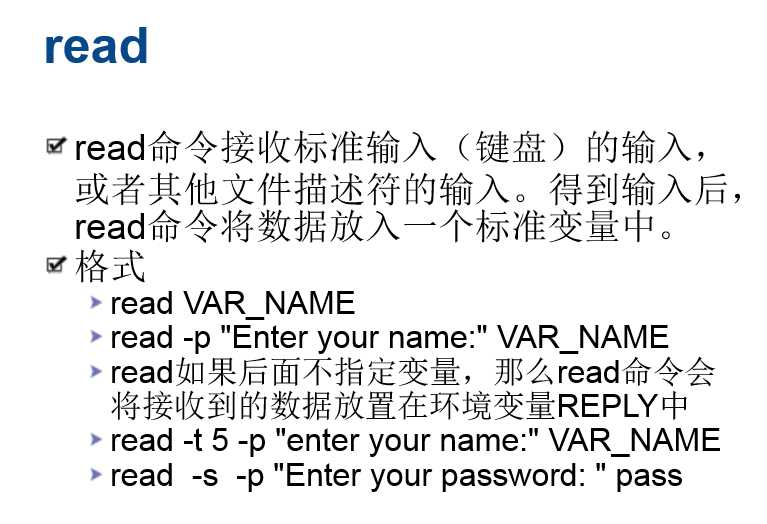

[root@weekend110 shell]# read weekend110
aaaa
[root@weekend110 shell]# echo $weekend110
aaaa
[root@weekend110 shell]# read -p "enter your name:" name
enter your name:zhouls
[root@weekend110 shell]# read -s -p "enter your password:" password
enter your password:[root@weekend110 shell]# echo $password
sss
[root@weekend110 shell]# read -p "enter your name:" name
enter your name:ss
[root@weekend110 shell]# read -t 3 -p "enter your name:" name 3秒之后,自动
enter your name:[root@weekend110 shell]#
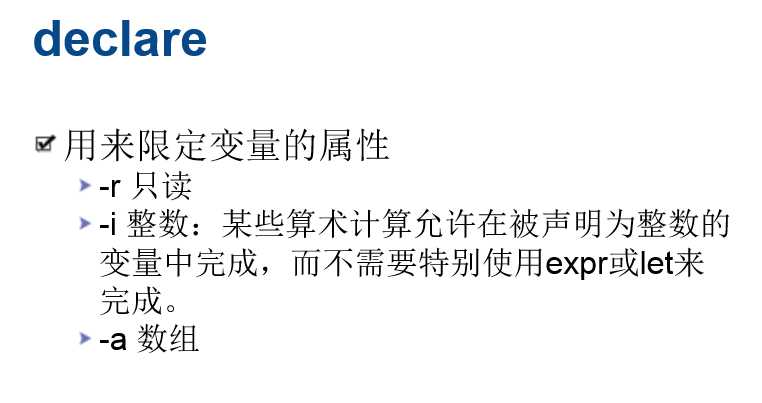
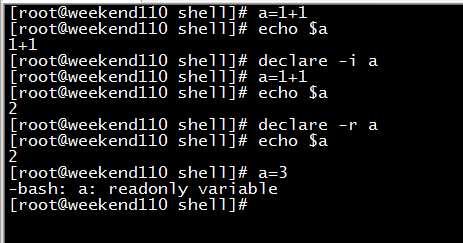
[root@weekend110 shell]# a=1+1
[root@weekend110 shell]# echo $a
1+1
[root@weekend110 shell]# declare -i a
[root@weekend110 shell]# a=1+1
[root@weekend110 shell]# echo $a
2
[root@weekend110 shell]# declare -r a
[root@weekend110 shell]# echo $a
2
[root@weekend110 shell]# a=3
-bash: a: readonly variable
[root@weekend110 shell]#
declare的数组,部分,后面更新。
除了使用echo $?获取函数返回值,在shell脚本里怎么获取?
答:还可以,a=$?
关于有几层循环就break?
答:
[root@weekend110 shell]# more break2.sh
#!/bin/bash
while [ 1 -eq 1 ]
do
for ((i=0;i<10;i++))
do
if [ $i -eq 2 ]
then
break //等价于 break 1,即退出当前for循环
fi
echo $i
done
echo ‘yes‘
sleep 1
done
[root@weekend110 shell]#
[root@weekend110 shell]# more break3.sh
#!/bin/bash
while [ 1 -eq 1 ]
do
for ((i=0;i<10;i++))
do
if [ $i -eq 2 ]
then
break 2 //跳出2循环,即先跳出for循环,再跳出while循环
fi
echo $i
done
echo ‘yes‘
sleep 1
done
[root@weekend110 shell]#
while(){
for(){
break
}
}
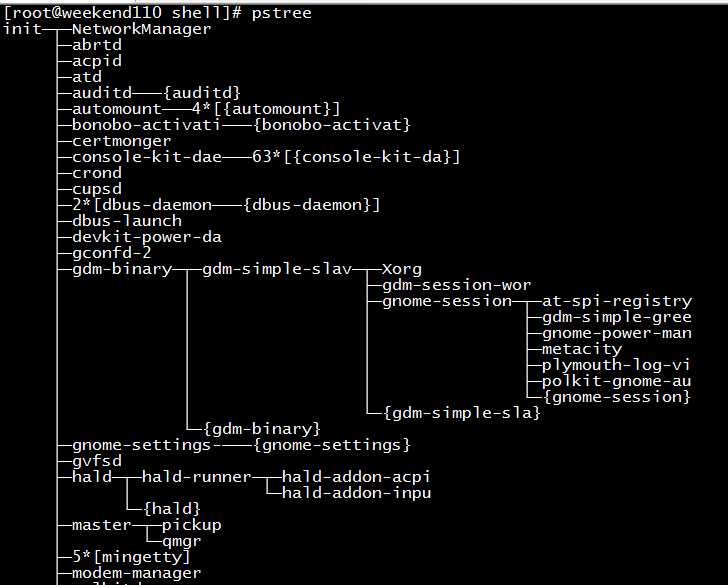
[root@weekend110 shell]# pstree
init─┬─NetworkManager
├─abrtd
├─acpid
├─atd
├─auditd───{auditd}
├─automount───4*[{automount}]
├─bonobo-activati───{bonobo-activat}
├─certmonger
├─console-kit-dae───63*[{console-kit-da}]
├─crond
├─cupsd
├─2*[dbus-daemon───{dbus-daemon}]
├─dbus-launch
├─devkit-power-da
├─gconfd-2
├─gdm-binary─┬─gdm-simple-slav─┬─Xorg
│ │ ├─gdm-session-wor
│ │ ├─gnome-session─┬─at-spi-registry
│ │ │ ├─gdm-simple-gree
│ │ │ ├─gnome-power-man
│ │ │ ├─metacity
│ │ │ ├─plymouth-log-vi
│ │ │ ├─polkit-gnome-au
│ │ │ └─{gnome-session}
│ │ └─{gdm-simple-sla}
│ └─{gdm-binary}
├─gnome-settings-───{gnome-settings}
├─gvfsd
├─hald─┬─hald-runner─┬─hald-addon-acpi
│ │ └─hald-addon-inpu
│ └─{hald}
├─master─┬─pickup
│ └─qmgr
├─5*[mingetty]
├─modem-manager
├─polkitd
├─pulseaudio───2*[{pulseaudio}]
├─rpc.statd
├─rpcbind
├─rsyslogd───3*[{rsyslogd}]
├─rtkit-daemon───2*[{rtkit-daemon}]
├─sshd───sshd───bash───bash───pstree
├─udevd───2*[udevd]
└─wpa_supplicant
[root@weekend110 shell]#
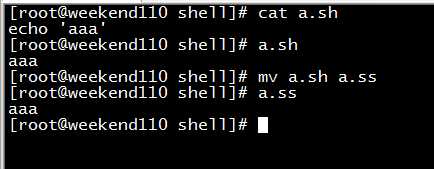
[root@weekend110 shell]# cat a.sh
echo ‘aaa‘ //因为系统,自带了#!/bin/bash/ ,但是,生产里,都要写,这是规范
[root@weekend110 shell]# a.sh
aaa
[root@weekend110 shell]# mv a.sh a.ss
[root@weekend110 shell]# a.ss //因为,对于linux里,后缀名无关。但是,生产里,都要写,.sh结尾的后缀,这是规范
aaa
[root@weekend110 shell]#
参考:
标签:添加空格 symbols symbol -- 十进制 play useful hal default
原文地址:http://www.cnblogs.com/zlslch/p/5986949.html